R-20: Difference between revisions
Pbcjohnston (talk | contribs) Added captions and photo album section |
Pbcjohnston (talk | contribs) Added new Header |
||
| (3 intermediate revisions by the same user not shown) | |||
| Line 1: | Line 1: | ||
[[File:R- | [[File:New Header 1 R-class.jpg]] | ||
[[File:R-12 with r-20.jpg|left|500px]] | [[File:R-12 with r-20.jpg|left|500px]] | ||
| Line 17: | Line 17: | ||
[[File:R-12 with r-20 upclose2.jpg|left|500px]] | [[File:R-12 with r-20 upclose2.jpg|left|500px]] | ||
<div style="text-align: justify;"><span style="color:#00008B">Another closeup showing R-12 moored inboard of the R-20. Crew are on deck. Three crew from the R-20 are seen in the center of the image. The man just to the right of the Chief appears to not be wearing a jumper but dressed in just a sleeveless T-shirt. To the left in the image a lone sailor seems to be either looking into a suitcase or, perhaps, playing a portable wind-up gramophone. It is hard to tell due to lack of resolution in the image. | <div style="text-align: justify;"><span style="color:#00008B">Another closeup showing R-12 moored inboard of the R-20. Crew are on deck. Three crew from the R-20 are seen in the center of the image. The man just to the right of the Chief appears to not be wearing a jumper but dressed in just a sleeveless T-shirt. To the left in the image a lone sailor seems to be either looking into a suitcase or, perhaps, playing a portable wind-up gramophone. It is hard to tell due to lack of resolution in the image. | ||
<small>Photo in the private collection of Ric Hedman</small> | <small>Photo in the private collection of Ric Hedman</small> | ||
| Line 94: | Line 87: | ||
The photos were taken over a span of time. In some of the images the three vertical stripes on the chariot bridge are missing and in others they are present. No attempt was made to sequence the photos by date. Instead they have been grouped by subject matter thereby creating a narrative on the page that is less scattered and more cohesive. | The photos were taken over a span of time. In some of the images the three vertical stripes on the chariot bridge are missing and in others they are present. No attempt was made to sequence the photos by date. Instead they have been grouped by subject matter thereby creating a narrative on the page that is less scattered and more cohesive. | ||
[[R-20 | [[R-20 Album|Click here for this photo album.]] | ||
[[File:Red bar sub new.jpg]] | [[File:Red bar sub new.jpg]] | ||
Latest revision as of 15:40, 17 March 2025
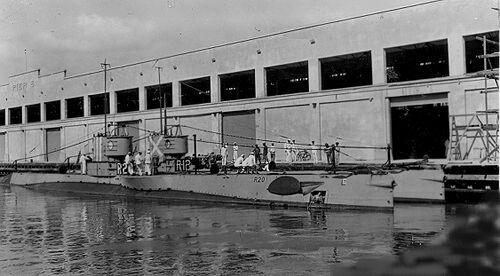
Photo in the private collection of Ric Hedman
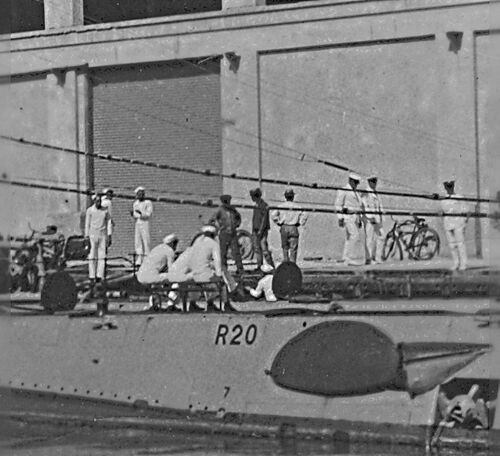
Photo in the private collection of Ric Hedman
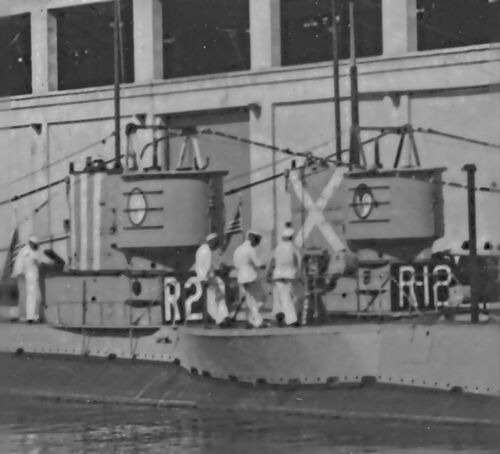
Photo in the private collection of Ric Hedman
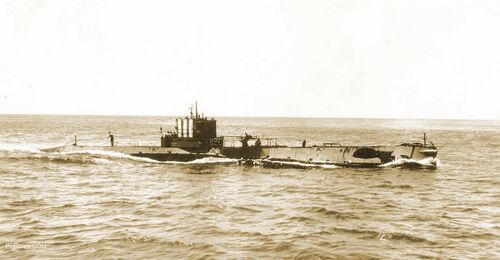
Photo in the private collection of Ric Hedman
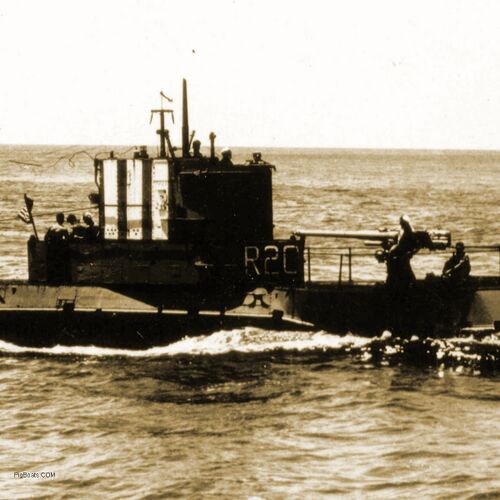
Photo in the private collection of Ric Hedman
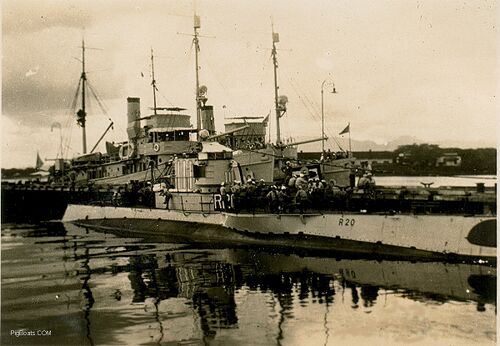
U.S. Navy photo.
Since it has been a couple of days since I served on the R-20 I wasn't sure I could remember too much to tell you but after reading Guy's comments lots of it sorta flooded back.
Like Guy, I didn't really care for a riveted submarine but when you're only 18 who knows. If it made it thru one war it ought to make another. Till the day the 12 boat went down. (USS R-12 was lost on 12-Jun-1943 with the loss of 42 officers and men when it foundered off Key West). We operated out of Key West mostly training fly boys in detection and also working with destroyers. Hindsight tells me we put lots of those boys in bad positions because we could only dive to 90 feet and when they got into real action they had a bit of trouble with subs at over 200'.
I came from Diesel school at the University of Missouri in Columbia, Mo. to New London for sub school and then to Key West to the R-20 as an MOMM2/c (Motor Machinist Mate second class) (no Enginemen in those days). Quite a change from a classroom with lots of space around the engines to a sardine can where when you oiled the valve push rods, which were on the outboard side of the engines, the sweat that was pouring off you evaporated totally on the side of your body next to the engine and ran like a river on the other side. And the exhaust manifolds, which were also on the outboard side would sear your flesh if you fell against them when the ship rolled in a storm. I carried the scars for many years.
I fully understand Guy's feeling when the ship rolls so far that you ship water down the conning tower hatch and with the engines online they pull a vacuum thru out the whole boat and really do a job on your ears. I know well the feeling when you can't dive over 90' and in a storm that is worse than on the surface so you stay on the surface. That is about the time one gets a distinct longing for the open ranges of Montana where the antelope roam!
The one really nice thing about serving on the R-20 was that you could go up into the conning tower when submerged and look out thru the glass port holes and watch all the critters swimming along with you. And also the crew was one of the gutsiest and bravest I have ever known and I'm honored to have served with them.
I left the 20 boat to put the USS Angler (SS-240), into commission and stayed with her for five patrol runs until 1945. Left the service in 1948 and went home to Montana to be a cowboy!
Hope this helps a little!
John Clarke EN 1/c

The R-20 was decommissioned at Key West 27 September 1945 and was struck from the Navy list the following month. On 13 March 1946, she was sold to Macey O. Scott of Miami, Fla. We know little about Mr. Scott, but we do know that he purchased several of the Key West based R-boats, ostensibly for scrap.
In this photo two young women are posing alongside the ex-R-20. Scott apparently spent several months displaying the boats to the public in the Miami area, in an attempt to make some additional cash before he had to scrap them. The boat looks to be some sort of exhibit, and it is also likely that no one was allowed aboard for safety reasons since the Navy had probably stripped the interior of any useful equipment during the decommissioning process. The printing on the hull was intended to give visitors some idea of the arrangement of the boat from the outside. We are guessing that based on the writing on the submarine that she is still in the Miami area with the “Se Habla Espanol” for the Cuban and Puerto Rican residents of the area. The women’s clothing seems to support a 1946 or 1947 timeframe. It is likely that Scott was not able to display the boats this way for very long, as the contract he signed with the government likely stipulating that he cut them up for scrap.
There is a second submarine on the right side of the photo and just the hint of a third, just above the “S” in “U.S.” and just to the right of the deck stanchion is the tip of a periscope from another submarine, likely one of the R-20’s R-class sisters.
Photo in the private collection of Ric Hedman
R-20 Photo Album
Especially important are the photos showing the modifications to the R-class hulls necessary for the transition from the 3"/23 caliber Mk 9 deck gun that these submarines were first outfitted with to the much more powerful 3"/50 caliber Mk 6 gun. This necessitated the enlargement of the deck area with sponsons to accommodate the larger swinging area for this gun.
The photos were taken over a span of time. In some of the images the three vertical stripes on the chariot bridge are missing and in others they are present. No attempt was made to sequence the photos by date. Instead they have been grouped by subject matter thereby creating a narrative on the page that is less scattered and more cohesive.
Click here for this photo album.
Page created by:
Ric Hedman & David Johnston
1999 - 2023 - PigBoats.COM©
Mountlake Terrace, WA, Norfolk, VA
webmaster at pigboats dot com
